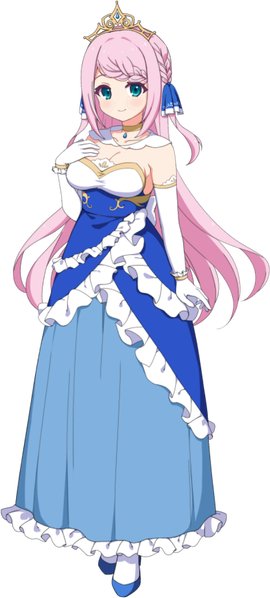Farringdon
| Farringdon | |||||
|---|---|---|---|---|---|
| Japanese Name | ファリンドン | 
| |||
| Race | Human | ||||
| Nationality | |||||
To all Train Knights, you have fought well. As the Divine Child, and as a St. Irish citizen, I thank you from the bottom of my heart. Miss Queensway. I have heard of a lot of your accomplishments. As a fellow St. Irish citizen, I am very proud of you.
Profile
The Divine Child Farringdon Elrond is the eldest sister of the royal House Elrond, followed by Kingston, Kensington, Islington and Paddington, and is considered to be the currently most powerful Divine Child after the deceased Ricardo Trevithick. Farringdon gets into arguments often with Kingston and Islington, as all three have a similarly stubborn personality.
Main Story
| Story Arc 1 & 2 |
|---|
|
Farringdon Elrond's name is mentioned by Islington as the eldest Elrond family and is in charge of managing the country of St. Iris and the Royal Guards, though not taking part in battles like the Out-Siders or the Special Steel Squad. |
| Story Arc 3 - World Wall |
|---|
|
Farringdon's debut was in the final scene of the Thorn Railway episode, saving Conductor's team just in time with Goddess St. Iris's divine lightning. The combined army outside of the Steel Thorns near the Iron Tree was finally able to clear a path thanks to the efforts by the SSS inside the ruins defeating the alpha leader of the machine soldiers. Farringdon's powers were directly by the Iridescent God St. Iris, hence the Railway Seeker have no defenses against it. Islington was very unhappy upon seeing Farringdon, with Mary surprised that she appeared personally considering her status as the head of St. Irish royalty spending most of her time shut inside the safety of the Royal Castle, and that neither Kingston nor Kensington could stop her. Islington eavesdropped on Islington speaking rather unrefinedly with Mary and she criticized her for it. Mary noticed that she doesn't seem to be able to detect sarcasm. When Farringdon gathered the Special Steel Squad together, Mary spoke of her displeasure with how the Royal Castle did virtually nothing when the Giant Trees are in danger, and accused her that the reasons she has appeared now is that she doesn't trust the SSS. Queensway and Yoshino expressed their doubts as well. Farringdon's reason was that she wants to marry Conductor, to everyone's surprise. Islington asked for clarification on the sudden marriage, Farringdon responded that the enemy wanted Conductor's Iron Injection powers to empower the Steel Tree. House Elrond has decided that Conductor should have as many successors as possible, and every Elrond should also bear his children as Conductor is the only person in the world who can move Ricardo Trevithick's Mist Train. This made Islington very furious with Farringdon's inconsideration towards the other Train Knights, and that she cannot fight in the front lines. Mary broke up the row in the end. The marriage announcement is a front however. Farringdon's true intentions are to get Islington into the SSS as she was very worried about Paddington's multiple occasions where she was possessed, and she secretly discussed this with the Conductor. Islington and Farringdon reconciled after Islington had a talk with Conductor and joined the SSS. Farringdon was under Yuuzen's protection after Islington boarded the Mist Train and entered the Tree, asking her how to exorcise Paddington's spirit, to which Yuuzen said Nishikese sorcery cannot do it, only a Divine Child could. As the Special Steel Squad was later flanked by machine soldiers and Mistism Cultists, Yuuzen and Farringdon were transferred via Gate right on time, and she led her forces into a massive fight as the Special Steel Squad took out the demonic beast guarding the Steel Tree Gate. After that, the Allied Forces made a temporary base near the entrance, as Farringdon discussed with each unit's leader on where to enter the Steel Tree. This was the first time Farringdon fought alongside other veterans under deep Phantom Mist, so she has first-hand experience of how it's like, and understood how the nobility are so sheltered from the danger, and why Mary deserted her position as Knight Commander out of frustration. After the surveillance of the Steel Tree, Farringdon insisted in going into the tree under Yuuzen's escort, she then parted ways with Islington and Conductor's team. By this point Farringdon and Islington has made up. While Conductor was ambushed by Alma and were escaping Youko's hexcast world, Farringdon and the elite alliance were slowly getting worn away by fights on every single floor inside the Steel Tree. Farringdon noticed Goddess St. Iris's power while they're discussing on how to proceed, and a rather unique Gate has appeared. Knowing that only Divine Children can enter this Gate, she proceeded in alone while the rest of the army were on standby. Farringdon rejoined Conductor's team using said Gate, and entered the Guardian's Chamber where they face the Mistism cult leader and Youko. Farringdon stopped everyone else from trying to touch the Steel Throne, as they'll all be completely drained of magic and die as a result. Tricked by Yuuzen, the cult leader was rejected by the Throne and corrupted herself into a monster instead, which the team fought and killed her. Conductor, Farringdon, Islington and Elrond then joined together under the God's guidance to cleanse the Throne and the Mist Core. The Tree was revived by Iridescent God Iris, and all the Gates inside were unlocked, and five iridescent beams are fired towards the four other Giant Trees to be cleansed of Phantom Mist, the fifth beam aiming towards a massive Sea of Fog that's never explored, indicating there's a sixth Giant Tree. |
Trivia
Counterpart
Farringdon is a London Underground and connected main line National Rail station in Clerkenwell, central London. The station is in the London Borough of Islington, just outside the boundary of the City of London. Opened in 1863 as the terminus of the Metropolitan Railway, the world's first underground passenger railway, Farringdon is one of the oldest surviving underground railway stations in the world. Today the station is served by the London Underground Circle, Hammersmith & City, and Metropolitan lines between King's Cross St Pancras and Barbican, the National Rail Thameslink route between St Pancras and City Thameslink, and the TfL Elizabeth line (since the opening of the line between Abbey Wood and Paddington on 24 May 2022).
The station was opened on 10 January 1863 as the terminus of the original Metropolitan Railway, the world's first underground metro line. The station, initially named Farringdon Street, was originally a short distance from the present station building. The line ran from the Farringdon area to Paddington, a distance of 4 mi (6 km). The station was relocated on 23 December 1865 when the Metropolitan Railway opened an extension to Moorgate. It was renamed Farringdon & High Holborn on 26 January 1922 when the new building by the architect Charles Walter Clark facing Cowcross Street was opened, and its present name was adopted on 21 April 1936. It was built in conjunction with a freight station to take livestock to a slaughterhouse to its south-east to supply Smithfield Market; remains of cattle ramps on a street outside the market, West Smithfield. Smithfield was redesignated as a wholesale 'deadmeat' market in the 19th century and the freight station was last used in the 1920s.
Farringdon Station has been rebuilt to accommodate longer Thameslink trains and to make other improvements to the station. The existing station building has been refurbished with a new roof canopy covering the north end of all four platforms and a new entrance and concourse facing Turnmill Street. An additional ticket hall has been built on the south side of Cowcross Street providing access to the Thameslink platforms, which have been extended southwards underneath this building, allowing the station to handle 240 m (12-carriage) trains. Platforms have been widened to accommodate increased passenger numbers. This process required the bridge that formed Cowcross Street to be demolished and rebuilt. Cowcross Street is now pedestrianised. Lifts have been provided throughout.
On the London Underground concourse, a memorial to Edward Johnston (the creator of the eponymous London Underground typeface) was designed by Fraser Muggeridge. Consisting of the letters of the alphabet in wood type set in Johnston, the memorial was unveiled by Sir Peter Hendy in 2019. As part of the Crossrail Art Programme, two artworks were commissioned from British artist Simon Periton. At the eastern entrance, the exterior glass of the station is printed with patterns echoing the Victorian ironmongery of the Smithfield Market located opposite the station entrance. At the western entrance, the glazing alongside the escalators are printed with giant diamonds, referencing the jewellers located nearby in Hatton Garden. Wiki
Map
Gallery
- Pages using DynamicPageList3 parser tag
- Human
- St. Iris
- Non-Playable Characters
- England






